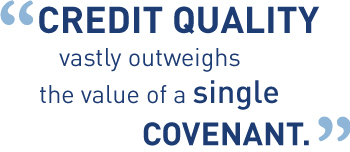In April 2013, our bank loan team published a white paper clarifying prevalent misconceptions about covenant-lite ("cov-lite") loans. We stressed that the credit quality of the company issuing the loan is ultimately far more important than the existence of a particular covenant.

More recently, we’ve come across additional commentary relating to the dynamics of cov-lite loans. In our view, Standard & Poor’s July 2014 piece, “Covenant-Lite Issuance Casts a Cloud Over Future Default Levels” and Moody’s June 2014 paper, “Time is Catching Up with Covenant-Lite,” contain some assumptions that need some careful consideration.
While S&P states that they do not believe cov-lite is inherently good or evil, their working assumptions are worthy of scrutiny. They assume that loans that will default will do so earlier if they have a maintenance financial covenant. S&P views earlier defaults as a positive, because their model assumes that defaulting companies will have valuations that only decline over time. Therefore, they assume if a cov-lite structure delays default, the recovery can only be worse.
Two important points:
-
The fact that cov-lite loans might altogether prevent default for bank lenders appears to be missing from their likelihood of default analysis. For example, the lack of a maintenance covenant might allow the financial sponsors to negotiate principal-reducing bond exchange offers without interference from bank lenders. This happened several times in the global financial crisis of 2008. After all, debt reduction is a positive for bank lenders.
-
In the real world, recovery does not automatically decline with the passage of time. Instead, recovery reflects the value that exists in the time in which recovery is negotiated. During the global financial crisis (as in all high default periods) recoveries were relatively low, but two years later valuations were higher. Merely delaying defaults may sometimes actually increase recovery, so slower-to-default cov-lite loans may receive that as a benefit.
Moody’s recognizes the potential for cov-lite loans to lead to bond exchanges without triggering bankruptcy, but then appears to confuse the implied value cushion below the loans with the amount of debt below the loans. Some cov-lite loans actually executed bond exchange offers during the global crisis without impacting the bank loans above them in the capital structure. Yet Moody’s writes that, "historically, debt cushion has been a very important determinant of recovery rates and its deterioration will have a negative impact on recovery rates."
Moody’s seems to suggest that an unequivocal good for lenders -- debt reduction below the loans without impairing the loans -- is actually bad. In our view, value and debt cushions are not the same thing; only value supports recovery rates. But the agencies have no sure way to determine the true value cushion as value estimation is not part of their core business. Moody's is left with debt principal as a value proxy; which seems to us a poor substitute. Like S&P, by focusing on recovery, Moody’s also misses the very important point that debt reduction is helpful for a stressed capital structure, thus lowering its likelihood of default -- and cov-lite loans can make that process easier.
Our opinion on cov-lite loans is unchanged
The lack of a maintenance financial covenant is not a valid reason to avoid investing in bank loans. Credit quality vastly outweighs the value of a single covenant. To these beliefs we will add another: good decisions are built on good analysis. Whether it is arbitrarily assuming cov-lite loans hurt recovery values, or not realizing that debt reduction below the loan is good for the loan, the implications of cov-lite status continue to be misunderstood by far too many.

Resources
S&P Capital IQ, “Leveraged Finance: Covenant-Lite Issuance Casts A Cloud Over Future Default Levels,” July 14, 2014, p.9-11
Moody’s Investor Service, “Covenant-Lite Defaults and Recoveries: Time Is Catching Up with Covenant Lite”, June 24, 2014, p.6
MALR012607
This blog post is provided for informational purposes only and should not be construed as investment advice. Any opinions or forecasts contained herein reflect the
subjective judgments and assumptions of the authors only and do not necessarily reflect the views of Loomis, Sayles & Company, L.P. Information, including
that obtained from outside sources, is believed to be correct, but Loomis Sayles cannot guarantee its accuracy. This material cannot be copied, reproduced or
redistributed without authorization. This information is subject to change at any time without notice. Market conditions are extremely fluid and change frequently.





